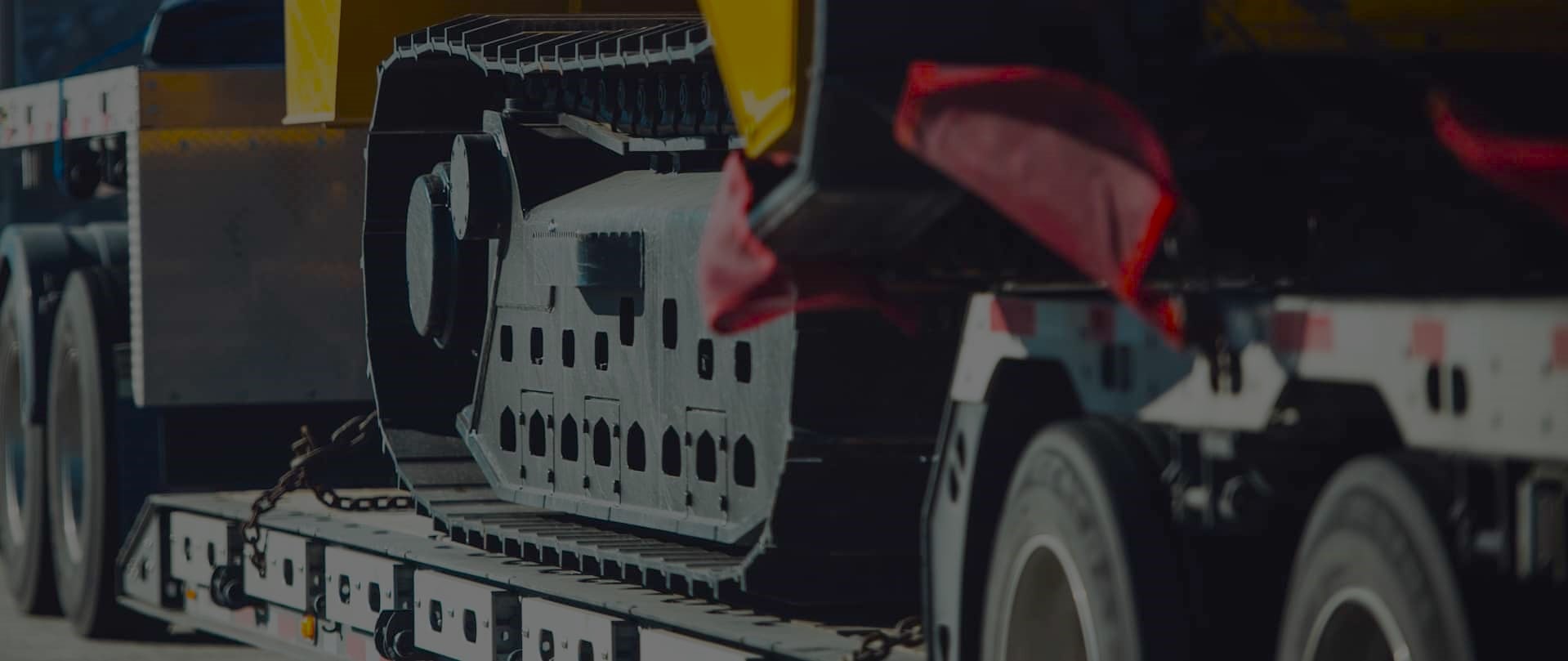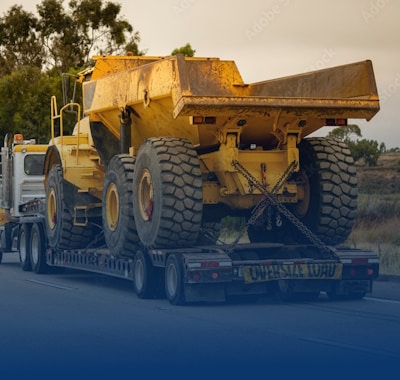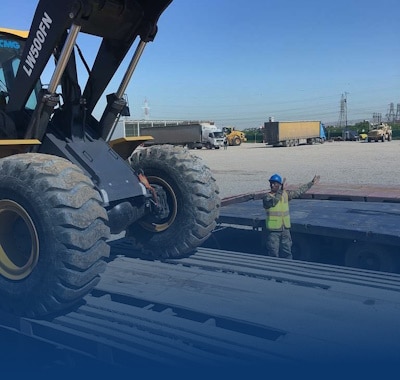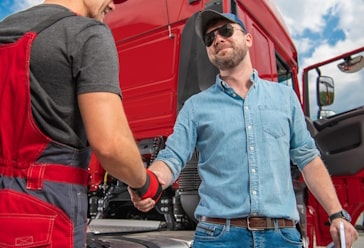Complying with Emissions Standards in Equipment Transportation
Freedom Heavy Haul can offer expedited Pickup and Delivery for any size shipment anywhere in the USA. Contact us today for No Hassle, No Pressure Pricing.
Emission regulations play a critical role in reducing air pollution and protecting our environment. For heavy-duty vehicles, these rules ensure that engines and fuel systems meet specific emission standards. This helps control pollutants and greenhouse gases, improving air quality across the nation.
Since 2007, the Environmental Protection Agency (EPA) has phased in stricter requirements for heavy-duty trucks and tractors. The California Air Resources Board (CARB) also finalized updated regulations in December 2021. These standards focus on reducing harmful emissions while promoting cleaner engine technologies.
Compliance is essential for manufacturers and fleet operators. Adhering to model year benchmarks and maintaining detailed records ensures smooth operations. Major industry players support these efforts, driving innovation in the sector.
This guide will walk you through the key steps to meet these requirements. From understanding emission regulations to implementing best practices, we’ll help you navigate the process with confidence.
Understanding Emissions Regulations in Heavy Hauling
The journey of emission regulations for heavy-duty vehicles has shaped the industry significantly. Over the years, these rules have evolved to address environmental concerns and improve air quality. Understanding this history helps us appreciate the progress made in reducing pollutants and promoting cleaner technologies.
Historical Context of EPA and CARB Rules
The Environmental Protection Agency (EPA) began regulating heavy-duty engine emissions in 1974. Initial rules focused on reducing carbon monoxide and hydrocarbons. By 1988, stricter limits were introduced to address nitrogen oxides and particulate matter.
In 2007, the EPA implemented a major update, setting new benchmarks for model year vehicles. These standards required advanced technologies like diesel particulate filters and selective catalytic reduction systems. Meanwhile, the California Air Resources Board (CARB) introduced even more stringent rules, often leading the way for federal regulations.
Overview of Federal and State Differences
Federal and state regulations often differ in their approach to emission control. While the EPA sets nationwide standards, states like California can adopt stricter rules under the Clean Air Act. This creates a dual system where manufacturers must meet varying requirements.
For example, CARB’s rules for heavy-duty trucks often include additional testing procedures like the Supplemental Emissions Test (SET) and Not-to-Exceed (NTE) limits. These measures ensure that vehicles perform well under real-world conditions, not just in controlled environments.
| Year | Milestone | Impact |
|---|---|---|
| 1988 | Introduction of nitrogen oxide limits | Reduced smog-forming pollutants |
| 1998 | Adoption of Ultra-Low Sulfur Diesel (ULSD) | Enabled cleaner engine technologies |
| 2007 | Implementation of stricter EPA standards | Required advanced emission control systems |
These milestones highlight the ongoing efforts to balance industry needs with environmental protection. By understanding these regulations, heavy hauling professionals can better navigate compliance and operational challenges.
Emission Regulations for Heavy‑Duty Vehicles and Equipment
Modern heavy-duty vehicles must meet stringent emission standards to protect the environment. These rules ensure that engines and fuel systems operate efficiently while minimizing harmful pollutants. For model year 2007 and later, the Environmental Protection Agency (EPA) has set specific benchmarks to reduce nitrogen oxides (NOx) and particulate matter.
Key Standards for MY 2007 and Later
The EPA’s regulations for heavy-duty vehicles include a NOx limit of 0.20 grams per brake horsepower-hour (g/bhp-hr). Particulate matter is capped at 0.01 g/bhp-hr. These standards require advanced technologies like selective catalytic reduction (SCR) and diesel particulate filters (DPFs).
SCR systems use a urea-based solution to convert NOx into nitrogen and water. DPFs trap soot and other particles, reducing air pollution. Together, these technologies help manufacturers meet emission limits while maintaining engine performance.
Technological Advancements and Fuel Requirements
Ultra-Low Sulfur Diesel (ULSD) is a critical component in meeting emission regulations. With a sulfur content of just 15 parts per million, ULSD enables cleaner combustion and protects catalytic filters from damage. This fuel formulation became mandatory in 2006, paving the way for stricter standards in 2007 and beyond.
Manufacturers also rely on rigorous testing protocols to ensure compliance. These include certification tests and real-world performance evaluations. By balancing environmental goals with operational efficiency, the industry continues to innovate and reduce its environmental footprint.
Key Requirements and Compliance Procedures
Meeting regulatory benchmarks is essential for heavy-duty vehicle operations. These standards ensure that engines and fuel systems perform efficiently while minimizing environmental impact. We’ll explore the critical aspects of useful life, warranty periods, and testing procedures to help you maintain compliance.
Useful Life and Warranty Benchmarks
Federal and state rules define specific useful life periods for heavy-duty vehicles. For example, engines must meet emission standards for 8 to 10 years or 110,000 to 290,000 miles, depending on the vehicle type. These benchmarks ensure long-term compliance and reduce air pollution over time.
Warranty periods also play a crucial role. Manufacturers must cover defects in emission control systems for at least 5 years or 100,000 miles. This protects fleet operators from unexpected costs and ensures engine performance remains consistent.
Supplemental and Not‑to‑Exceed Testing Explained
Supplemental Emission Testing (SET) and Not‑to‑Exceed (NTE) limits are key to verifying compliance. SET evaluates engine emissions under various operating conditions, while NTE ensures pollutants stay below specific thresholds during real-world use.
These tests are critical for heavy-duty trucks and tractors. They ensure that emission control systems function effectively, even under demanding conditions. Regular testing and record-keeping are essential for maintaining compliance and avoiding penalties.
| Test Type | Purpose | Key Requirements |
|---|---|---|
| SET | Evaluate emissions under varied conditions | Measure NOx, PM, and CO levels |
| NTE | Ensure real-world compliance | Limit emissions during peak operations |
By adhering to these requirements, fleet operators and manufacturers can ensure safer, cleaner transport operations. For more insights, explore our guide on specialized transport services.
Practical Tips for Complying with Emissions Standards in Equipment Transportation
Effective record-keeping and maintenance are key to meeting emission regulations. These practices ensure that your fleet operates efficiently while minimizing environmental impact. By following structured procedures, you can achieve long-term compliance and reduce downtime.
Documenting Compliance and Record-Keeping
Accurate documentation is essential for proving compliance with emission standards. Start by maintaining detailed logs of all maintenance activities, including dates, tasks performed, and parts replaced. Use digital tools to streamline this process and ensure data accuracy.
Manufacturer guides and online compliance summary tools can help you stay organized. These resources provide step-by-step instructions for tracking engine performance and emission control systems. Regular audits of your records will help identify gaps and ensure accountability.
Implementing Regular Maintenance Checks
Periodic maintenance is crucial for keeping your heavy-duty vehicles in top condition. Schedule routine inspections to check engine components, fuel systems, and emission control devices. Address issues promptly to avoid costly repairs and ensure compliance.
Here’s a quick guide to essential maintenance tasks:
| Task | Frequency | Benefit |
|---|---|---|
| Inspect diesel particulate filters | Every 3 months | Reduces particulate matter emissions |
| Check selective catalytic reduction systems | Every 6 months | Ensures NOx levels stay within limits |
| Monitor fuel injectors | Annually | Improves fuel efficiency and reduces emissions |
By adhering to these practices, you can enhance fleet reliability and meet emission regulations with confidence.
Leveraging Technology for Emission Reduction
Cutting-edge technologies are transforming how we tackle emissions in heavy-duty vehicles. These innovations not only reduce harmful pollutants but also enhance engine performance and fuel efficiency. By adopting advanced systems, fleet operators can meet emission regulations while maintaining operational excellence.
Catalytic Diesel Particulate Filters
Catalytic diesel particulate filters (DPFs) are a game-changer in emission control. These devices capture soot and particulate matter (PM) from engine exhaust, preventing them from entering the air. Over time, the trapped particles are burned off through a process called regeneration, ensuring the filter remains effective.
Compared to older systems, DPFs reduce PM emissions by up to 90%. This makes them essential for meeting modern emission standards. Regular maintenance is crucial to keep these filters functioning optimally and avoid costly repairs.
Selective Catalytic Reduction (SCR) Techniques
Selective catalytic reduction (SCR) is another breakthrough technology. It uses a urea-based solution to convert nitrogen oxides (NOx) into harmless nitrogen and water. This process can reduce NOx emissions by up to 90%, significantly improving air quality.
SCR systems are now standard in most heavy-duty trucks. They work alongside DPFs to ensure comprehensive emission control. By integrating these technologies, manufacturers can meet stringent regulations while enhancing engine efficiency.
For more insights on maintaining compliance in heavy haul operations, explore our guide on DOT regulations for heavy haul transportation.
Navigating Regulatory Changes and Industry Updates
The landscape of heavy-duty vehicle regulations is evolving rapidly. With new proposals from the EPA and shifts in state policies, staying informed is crucial for compliance. We’ll explore the latest updates and provide actionable insights to help you prepare for the future.
Updates from the EPA and Future MY 2027 Standards
In March 2022, the EPA proposed stricter emission rules for model year 2027 and beyond. These changes aim to reduce tailpipe pollutants significantly. For heavy-duty trucks, the focus is on lowering nitrogen oxides (NOx) and particulate matter (PM).
The proposed standards will require advanced engine technologies and cleaner fuel systems. This shift will likely increase upfront costs but offer long-term environmental and operational benefits. Fleet operators should start planning now to meet these future regulations.
Preparing for Shifts in Federal and State Policies
Federal and state policies often differ, adding complexity to compliance. States like California have historically led with stricter rules, influencing national standards. Understanding these differences is key to navigating the regulatory landscape.
Here’s how you can prepare:
- Invest in cleaner engine technologies like SCR and DPFs.
- Stay updated on state and federal regulation changes.
- Work closely with manufacturers to ensure your fleet meets new standards.
By taking these steps, you can ensure smooth operations and maintain compliance as emission rules evolve.
Proactive planning is essential in this dynamic environment. We’re here to guide you through these changes, ensuring your fleet remains efficient and compliant. Stay ahead by embracing innovation and staying informed about industry updates.
Managing Fleet Operations for Emission Compliance
Ensuring your fleet meets emission rules requires strategic planning and daily attention. By embedding compliance into everyday operations, fleet managers can maintain regulatory conformity while optimizing performance. This section explores practical methods to integrate compliance into daily routines and highlights best practices for heavy-duty fleet maintenance.
Integrating Compliance into Daily Operations
Daily fleet management should prioritize emission rules to avoid costly penalties and downtime. Start by creating a compliance checklist that includes routine inspections, engine diagnostics, and fuel system checks. Digital tools like fleet management software can streamline this process by providing real-time monitoring and alerts.
Training staff on new compliance procedures is equally important. Regular workshops and updates ensure that everyone understands the latest regulations and their role in maintaining compliance. This proactive approach reduces errors and fosters a culture of accountability.
- Use digital platforms for real-time emission monitoring.
- Conduct regular training sessions for staff.
- Maintain detailed logs of inspections and repairs.
Best Practices for Heavy-Duty Fleet Maintenance
Routine maintenance is the backbone of compliance. Schedule periodic checks for engine components, emission control systems, and fuel injectors. Addressing issues promptly ensures that your fleet operates efficiently and meets standards.
Here’s a quick maintenance guide:
- Inspect diesel particulate filters every 3 months.
- Check selective catalytic reduction systems every 6 months.
- Monitor engine performance annually.
Proactive maintenance not only ensures compliance but also extends the lifespan of your vehicles. By following these practices, fleet managers can reduce operational costs and enhance safety.
Successful fleets often use case studies to refine their strategies. For example, a leading truck manufacturer reduced emissions by 30% through regular maintenance and staff training. These examples highlight the importance of aligning operational practices with regulatory requirements.
We’re here to help you navigate these challenges with confidence. By leveraging our expertise, you can ensure your fleet remains compliant and efficient, even as rules evolve.
Resources and Tools for Streamlined Compliance
Navigating emission rules can be complex, but the right tools make it manageable. We’ve curated a list of resources to help you stay compliant while reducing administrative burdens. From online tools to manufacturer guides, these resources simplify the process and ensure your fleet meets the latest regulations.
Online Compliance Summary Tools
Online tools are invaluable for tracking compliance and managing documentation. Platforms like the EPA’s Compliance Assistance Center provide summaries of emission standards and testing requirements. These tools help fleet managers stay organized and avoid costly penalties.
Here’s how these tools can benefit your operations:
- Real-time monitoring of engine performance and emission levels.
- Automated alerts for upcoming inspections or regulation updates.
- Centralized data storage for easy access to compliance records.
By leveraging these tools, you can streamline your compliance process and focus on improving fleet efficiency.
Accessing Manufacturer and Regulatory Guides
Manufacturer guides are another essential resource. They provide detailed instructions for maintaining emission control systems and ensuring engine performance. Regulatory guides, such as those from the EPA or CARB, offer updates on new rules and testing procedures.
Here’s how to make the most of these guides:
- Download the latest manuals for your vehicle models.
- Attend webinars or workshops hosted by manufacturers.
- Use these resources to train your team on new compliance procedures.
These guides not only simplify compliance but also help you stay ahead of regulatory changes. For more insights on managing complex transportation needs, explore our guide on transporting large machinery.
Investing time in these resources pays off in the long run. They reduce administrative burdens, improve efficiency, and ensure your fleet remains compliant. By staying informed and proactive, you can navigate emission rules with confidence.
Final Thoughts on Achieving Emission Compliance in Equipment Transportation
Achieving emission compliance is not just a regulatory requirement but a commitment to a cleaner future. Throughout this guide, we’ve explored the importance of understanding regulations, leveraging advanced technologies, and implementing practical maintenance practices. Staying informed about evolving rules ensures your vehicles meet the latest standards while protecting the environment.
Proactive engagement with new engine technologies and regular maintenance checks can lead to significant cost savings and operational efficiency. By prioritizing compliance, fleet managers not only avoid penalties but also contribute to long-term environmental sustainability.
We’re here to support you every step of the way. Our expertise in heavy-duty transportation ensures your trucks and equipment operate safely and efficiently. Review your current practices today and embrace the benefits of compliance. Together, we can build a cleaner, more sustainable future.







